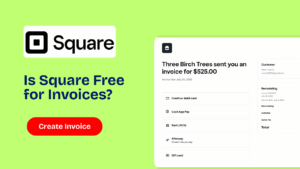As a small business owner, creating professional invoices is a critical part of getting paid, tracking income, and maintaining accurate records. Whether you sell products or services, an invoice communicates what you’re owed, how your client can pay you, and when.
The good news? You don’t need expensive software or advanced accounting knowledge. In this complete guide, we’ll show you exactly how to create a clear, simple, and effective invoice for your small business.
Table of Contents
Toggle🧾 What Is an Invoice?
An invoice is a commercial document sent by a seller to a buyer, itemizing and detailing a transaction and requesting payment. It typically includes:
- The seller and buyer information
- Description of goods/services
- Quantity and price
- Payment terms
- Total amount due
Invoices serve as both a formal payment request and a legal record of a sale. They’re crucial for tracking finances, managing taxes, and establishing professionalism.
🏢 Why Are Invoices Important for Small Businesses?
Creating accurate invoices is essential for small business success. Here’s why:
- ✅ Ensures timely payments
- ✅ Maintains professionalism
- ✅ Helps with tax filing and audits
- ✅ Tracks cash flow
- ✅ Protects against disputes
A sloppy invoice or no invoice at all can lead to missed payments, confusion, and legal troubles. That’s why using a clear and structured process is key.
📋 What to Include in a Small Business Invoice
A professional invoice doesn’t need to be complicated, but it should contain certain elements. Here’s what every small business invoice should include:
1. Your Business Details
Include your:
- Business name or your name if self-employed
- Address
- Phone number
- Logo (optional but adds professionalism)
2. Customer Information
Include the recipient’s:
- Full name or business name
- Address
- Contact details
3. Invoice Number
Assign a unique invoice number (e.g., #1001). This helps with:
- Record-keeping
- Avoiding duplicate invoices
- Easy reference for clients and accountants
4. Invoice Date and Due Date
- Invoice Date: Date of creation
- Due Date: When payment is expected (e.g., Net 7, Net 15, Net 30)
5. Itemized List of Products/Services
List each item provided. For each line, include:
- Description
- Quantity
- Unit price
- Total amount for that line
6. Subtotal, Taxes, Discounts
- Show the subtotal before taxes
- Add tax (if applicable)
- Deduct any discounts
7. Total Amount Due
Clearly state the total the client must pay.
8. Payment Instructions
Mention accepted payment methods such as:
- Bank transfer
- UPI
- PayPal
- Stripe
- Credit card
9. Notes or Terms
You can include:
- A thank-you message
- Late payment terms (e.g., 2% late fee after 10 days)
- Warranty or return info (for products)
🛠️ How do I create an invoice for a small business?
There are three main ways to generate an invoice:
Option 1: Use Word or Excel Templates
You can manually create an invoice in Microsoft Word or Excel.
Pros:
- Flexible
- Free if you have the software
Cons:
- Time-consuming
- Manual calculations
- Easy to make errors
Option 2: Download Free Invoice Templates
Google Docs and other platforms offer downloadable templates.
Pros:
- Easy to access
- No special software required
Cons:
- Templates can be rigid
- Hard to customize
- Still requires manual editing
✅ Option 3: Use a Free Invoice Generator Like MyInvoiceCreator.com
MyInvoiceCreator.com is a free, easy-to-use online tool specifically built for small business owners and freelancers. You can generate a professional-looking invoice in minutes — no login required.
🔍 Features of MyInvoiceCreator.com
- Simple interface — no technical skills needed
- Automatically calculates totals, taxes, and discounts
- Add your logo and brand details
- Customizable fields
- Download invoice as PDF instantly
- 100% free to use
👣 Step-by-Step: Create a Small Business Invoice with MyInvoiceCreator
Step 1: Visit https://myinvoicecreator.com
No registration needed.
Step 2: Enter Your Business Info
Fill in your company name, address, contact details, and logo.
Step 3: Add Customer Information
Input your client’s name, address, and contact info.
Step 4: Assign Invoice Number & Dates
- Choose a unique invoice number (e.g., #2024-101)
- Set the invoice and due dates
Step 5: Itemize Products or Services
Add each item/service provided with quantity, unit price, and description.
Step 6: Taxes & Discounts
- Add tax rate if applicable
- Enter any discounts if provided
Step 7: Review & Download PDF
Preview your invoice and download it instantly as a high-resolution PDF. You can now send it by email or print it for physical delivery.
💡 Invoice Example for Small Business
Here’s what a simple invoice might look like for a home repair business:
Invoice #0028
Invoice Date: May 9, 2025
Due Date: May 16, 2025
| Description | Qty | Unit Price | Total |
|---|---|---|---|
| Plumbing Repairs | 1 | $150 | $150.00 |
| Pipe Replacement | 2 | $45 | $90.00 |
| Subtotal | $240.00 | ||
| Tax (10%) | $24.00 | ||
| Total Amount Due | $264.00 |
Payment via Bank Transfer
Thank you for your business!
🚫 Common Invoice Mistakes to Avoid
- Forgetting to include a due date
- Misspelling client names
- Missing invoice numbers
- Incorrect total calculation
- Not specifying payment methods
- Not keeping copies of sent invoices
💰 How Often Should You Invoice?
Here are a few standard practices:
- Per project: After completion
- Monthly: For ongoing work
- Milestone-based: For large contracts
- Before delivery: For prepaid orders
Whatever method you choose, be consistent and communicate clearly with clients.
🌐 Invoicing for International Clients
If your small business serves international customers:
- Use USD or EUR
- Mention your SWIFT code for bank transfers
- Specify any international processing fees
- Use tools like PayPal or Wise for easy conversion and payment
MyInvoiceCreator.com supports multi-currency input and allows full customization for international invoicing.
📦 Can Product-Based Businesses Use Online Invoices?
Absolutely. Whether you run an online store, a local shop, or a delivery-based business, invoices help:
- Track sales
- Reduce cash-flow issues
- Serve as proof of purchase
- Simplify returns and exchanges
You can even include shipping fees, product codes, or warranty notes on invoices created with MyInvoiceCreator.
Frequently Asked Questions (FAQ)
How can I create a small business invoice for free?
You can use https://myinvoicecreator.com to generate professional invoices completely free without registering or installing software.
What should be on a small business invoice?
A complete small business invoice should include your business info, client info, invoice number, dates, itemized charges, taxes, and payment terms.
Is there a mobile-friendly invoice generator?
Yes. MyInvoiceCreator is fully mobile-responsive and works smoothly on phones and tablets.
Can I download the invoice as a PDF?
Yes. After generating your invoice, you can instantly download a high-quality PDF for emailing or printing.
Can I include my company logo?
Yes. MyInvoiceCreator allows you to upload and position your logo for professional branding.
Do I need an account?
No login or sign-up is required to use MyInvoiceCreator.com. It’s completely free and hassle-free.
Creating invoices for your small business doesn’t have to be stressful or expensive. By following a simple structure and using tools like MyInvoiceCreator.com, you can ensure fast, professional, and accurate billing — and get paid faster.
Take control of your business finances with organized invoicing. It’s easy, free, and saves time.
Start creating invoices now at https://myinvoicecreator.com.







